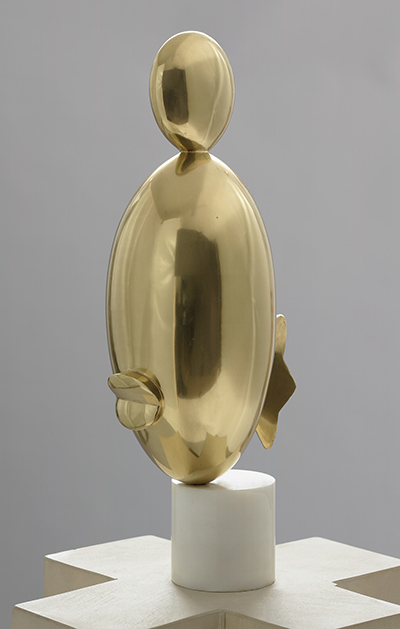Located and displayed at the San Fransisco museum of modern art, The Blonde Negress dates from 1926. It was part of a series of which the first, The White Negress, was crafted in veined white marble.
This piece is made from bronze, which cuts a striking contrast with the materials used in the sculpture's base, which is itself a work of art. Fashioned of carved wood, limestone and marble, Brancusi almost uses a hierarchy of medium, beginning with the local carpenter's bench, progressing through to church stone and finally sepulchral or palatial marble. Perhaps this reflects the fluidity of Brancusi's perception of humans and the social divides between them.
Brancusi works always with ambiguity. The inspiration behind this series of sculptures was inspired by a colonial woman Brancusi saw during a colonial fair at Marseilles in 1922. Being of Romanian origin, whilst living and travelling widely throughout Europe, Brancusi was perhaps especially open to different cultural influences, including non-Western art forms and styles he encountered. The Blond Negress is named, therefore we know that it is a portrait and that it depicts a person, though Brancusi was ever the master of ambiguity. The artist was open about his influences, therefore we know we are looking at a representation of someone specific, albeit someone whose name was not known.
Brancusi's bronze person reveals a representation of facial features such as a mouth and topknot of hair. Its oval plains suggest an individual of grace and symmetry, whilst his choice of medium suggests the person who inspired the work was striking. Brancusi often stated that the only real aspect of a person was their essence. Knowing this, it is reasonable to assume that everything Brancusi observed and that struck him about a particular woman can be found within what the eye sees: thus we have radiance, strong yet elegant lines, and a diversity in medium. This may indicate that Brancusi perceived beauty in differences, thus a woman whose complexion contrasted to the colour of her hair.
Marble, limestone and wood are also remarkably different materials to have chosen for the sculpture's pedestal, and as well as representing a hierarchy of mediums, they may echo elements of a colonial costume: beads and bracelets. The Blond Negress is an excitingly open work, and it is possible to infer that because Brancusi chose reflective brass to fashion the woman's body and head, he also wished us to understand that the reality is reflected in our own eyes. The viewers or audience, as well as the surrounding environs, are as much a part of the sculpture as the physical thing. There is the raw effect of the object itself upon us, then there is also what the sculpture means to every individual who views it, including their context or background.




